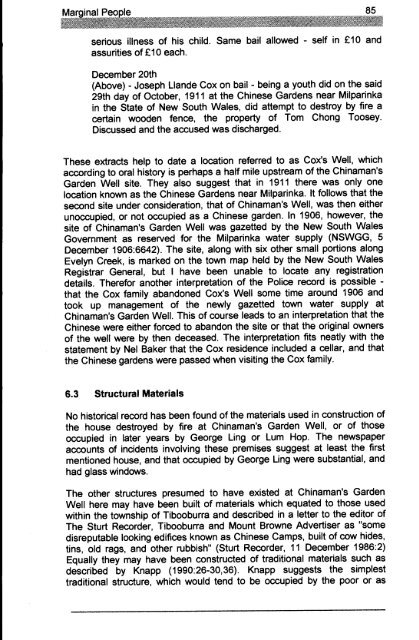Adec Preview Generated PDF File - The Sydney eScholarship ...
Adec Preview Generated PDF File - The Sydney eScholarship ...
Adec Preview Generated PDF File - The Sydney eScholarship ...
You also want an ePaper? Increase the reach of your titles
YUMPU automatically turns print PDFs into web optimized ePapers that Google loves.
serious illness of his child. Same bail allowed - self in £10 and<br />
assurities of £10 each.<br />
December 20th<br />
(Above) - Joseph L1ande Cox on bail - being a youth did on the said<br />
29th day of October, 1911 at the Chinese Gardens near Milparinka<br />
in the State of New South Wales, did attempt to destroy by fire a<br />
certain wooden fence, the property of Tom Chong Toosey.<br />
Discussed and the accused was discharged.<br />
<strong>The</strong>se extracts help to date a location referred to as Cox's Well, which<br />
according to oral history is perhaps a half mile upstream of the Chinaman's<br />
Garden Well site. <strong>The</strong>y also suggest that in 1911 there was only one<br />
location known as the Chinese Gardens near Milparinka. It follows that the<br />
second site under consideration, that of Chinaman's Well, was then either<br />
unoccupied, or not occupied as a Chinese garden. In 1906, however, the<br />
site of Chinaman's Garden Well was gazetted by the New South Wales<br />
Government as reserved for the Milparinka water supply (NSWGG, 5<br />
December 1906:6642). <strong>The</strong> site, along with six other small portions along<br />
Evelyn Creek, is marked on the town map held by the New South Wales<br />
Registrar General, but I have been unable to locate any registration<br />
details. <strong>The</strong>refor another interpretation of the Police record is possible <br />
that the Cox family abandoned Cox's Well some time around 1906 and<br />
took up management of the newly gazetted town water supply at<br />
Chinaman's Garden Well. This of course leads to an interpretation that the<br />
Chinese were either forced to abandon the site or that the original owners<br />
of the well were by then deceased. <strong>The</strong> interpretation fits neatly with the<br />
statement by Nel Baker that the Cox residence included a cellar, and that<br />
the Chinese gardens were passed when visiting the Cox family.<br />
6.3 Structural Materials<br />
No historical record has been found of the materials used in construction of<br />
the house destroyed by fire at Chinaman's Garden Well, or of those<br />
occupied in later years by George Ling or Lum Hop. <strong>The</strong> newspaper<br />
accounts of incidents involving these premises suggest at least the first<br />
mentioned house, and that occupied by George Ling were substantial, and<br />
had glass windows.<br />
<strong>The</strong> other structures presumed to have existed at Chinaman's Garden<br />
Well here may have been built of materials which equated to those used<br />
within the township of Tibooburra and described in a letter to the editor of<br />
<strong>The</strong> Sturt Recorder, Tibooburra and Mount Browne Advertiser as "some<br />
disreputable looking edifices known as Chinese Camps, built of cow hides,<br />
tins, old rags, and other rubbish" (Sturt Recorder, 11 December 1986:2)<br />
Equally they may have been constructed of traditional materials such as<br />
described by Knapp (1990:26-30,36). Knapp suggests the simplest<br />
traditional structure, which would tend to be occupied by the poor or as




